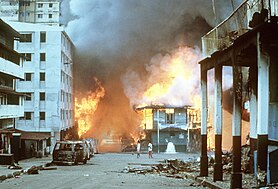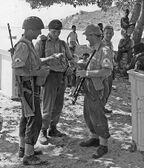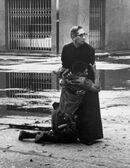Satavian Crisis
| Satavian Crisis | |||||||
|---|---|---|---|---|---|---|---|
Clockwise from top: Battle of Krugersdorp • Aid from the Father • Bombing of Henschhoek City Police Headquarters • Satavian paratroopers in the Patrick Islands after Operation Thunderbolt | |||||||
| |||||||
| Belligerents | |||||||
|
Supported by: Template:Country data Estmere |
Others Supported by: | ||||||
| Commanders and leaders | |||||||
|
Political leaders: Military leaders: |
| ||||||
| Casualties and losses | |||||||
|
4,986 soldiers killed 15,854 soldiers injured 63 police killed 151 police injured 4 soldiers killed |
2,151 killed 187 killed 4,139 captured 2,748 killed 769 killed | ||||||
|
Civilians killed: 8,594 Total dead: 19,502 | |||||||
The Satavian Crisis, often referred to in Satavia as The Emergency, was a period of instability and insurgency that began in 1976 and ended in 1983 in Satavia. Beginning after the fall of the National Party dictatorship in a 1976 coup d'état, the conflict initially centred primarily around the Orange Province, but had spilled over into the rest of Satavia by the end of 1981. The conflict was fought largely between the government and armed forces of Satavia against several far-right paramilitary groups, opposed to the fall of the National Party regime and election of a socialist government, the largest of which was De Volksmilitie. The conflict began as a low-level disturbance in National Party strongholds within the Orange Province, but by 1977 had escalated into an insurgency. The large-scale deployment of Satavian troops began in March 1977 across the Orange Province, and the government declared a state of emergency on 14 March 1977. The passage of the Military Powers (Martial Law) Act 1977 saw large swathes of the Orange Province turned over from civilian control to the military and brought with it an escalation in the conflict. Whilst some pitched battles did occur during the conflict, notably at Kellerstad, Patrick's Town and Krugersdorp. 1980 marked the bloodiest year in the conflict, and saw the deployment of an OAN intervention lead by Nuvanian and Rizealander military forces. By 1982, the government had regained control over most of the Orange Province, with paramilitaries limited to rural areas within the Orange Province and Central Territory. The surrender of the neo-functionalist ASW in July 1982 marked a decisive victory for the government, and in December 1982 the largest paramilitary force - De Volksmilitie - had entered into secret negotiations with the government. The conclusion of the Vooneeaboo Talks in February 1983 saw disarmament and disbanding of De Volksmilitie, and an end to widespread fighting. The Oranje Liga would disband itself in late 1983 and in November 1983 the government declared victory and ended the state of emergency that had existed since 1977. Although sporadic acts of violence would occur until as late as 1995, the conflict is generally regarded to have ended in late 1983. The Roebuck House Agreement, reached in 1985 under the government of Leander Kokkinakis, led to a controversial amnesty for members and leaders of paramilitary groups and the release of some 10,000 people interned under Martial Law in the Orange Province since 1977.
The conflict, although primarily ideological in nature, was also driven by historical causes, belief in white supremacy, fierce anti-socialism and ultranationalism. 19,502 people were killed throughout the conflict and at least 25,000 further people were injured. The conflict has had long-lasting impacts culturally, politically and socially and continues to shape Satavian identity. Although usually described as an insurgency, conflict or low-level war it is described officially as an "insurgency and state of emergency". It has also been referred to as a civil war. The conflict is known internationally as the "Satavian Crisis" but is often referred to as "The Emergency" in Satavia.



